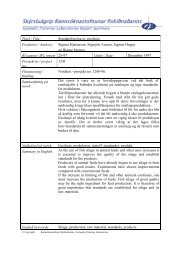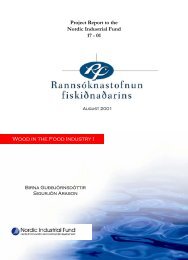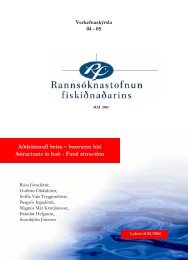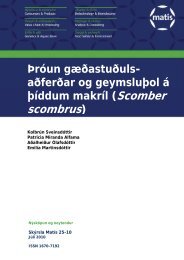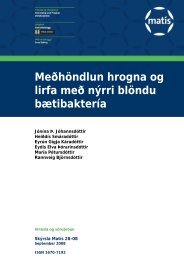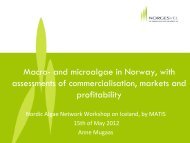Microbiology and Spoilage Trail in Nile Perch (Lates niloticus), Lake ...
Microbiology and Spoilage Trail in Nile Perch (Lates niloticus), Lake ...
Microbiology and Spoilage Trail in Nile Perch (Lates niloticus), Lake ...
Create successful ePaper yourself
Turn your PDF publications into a flip-book with our unique Google optimized e-Paper software.
• Pseudomonas <strong>and</strong> Shewanella putrifaciens are specific spoilage bacteria of iced fresh<br />
fish <strong>and</strong> fish products under refrigeration conditions (Gram <strong>and</strong> Huss 1996; Taoukis et<br />
al., 1999).<br />
• Pseudomonas which is a large <strong>and</strong> poorly def<strong>in</strong>ed group of microorganisms. The genus<br />
is <strong>in</strong> the group of aerobe Gram-negative, catalase <strong>and</strong> oxidase-positive rods. Many<br />
species have a psychrophilic nature <strong>and</strong> are regarded as part of the natural flora of fish<br />
(Hvda, 2007). The species can form aldehydes, ketones, esters <strong>and</strong> sulphides follow<strong>in</strong>g<br />
food spoilage, caus<strong>in</strong>g odours described as fruity, rotten <strong>and</strong> sulfhydryl-like (Lund et<br />
al., 2000).<br />
• Shewanella spp. <strong>and</strong> S. putrefaciens: The bacterium Shewanella is a facultative<br />
anaerobe Gram-negative, oxidase- <strong>and</strong> catalase- positive rod <strong>in</strong> the Shewanellacea<br />
family. S. putrefaciens is regarded as a specific spoilage bacterium of mar<strong>in</strong>e fish from<br />
temperate water, stored aerobically <strong>in</strong> ice (Gram et al., 1987; Gram & Huss, 1996).<br />
• Hozbor et al., (2006), identified bacterial flora <strong>in</strong> iced sea salmon that consisted of<br />
Pseudomonas spp., S. putrefaciens, <strong>and</strong> Aeromonas which dom<strong>in</strong>ated the spoilage trail<br />
as well as Moraxella spp., Ac<strong>in</strong>etobacter <strong>and</strong> lactose positive- Enterobactereaceae <strong>and</strong><br />
Vibrios spp. They are predom<strong>in</strong>ant spoilage species on chilled fresh fish under aerobic<br />
conditions, (Fonnesbech et al., 2005; Hozbor et al., 2006).<br />
• Aeromonas hydrophila, a fermentative Gram –negative bacteria, produces characteristic<br />
spoilage off-flavour <strong>in</strong> fish stored <strong>in</strong> ice.<br />
• Alteromonas putrefaciens (former Pseudomonas putrefaciens), non fermentative, H2S<br />
produc<strong>in</strong>g organism was detected by us<strong>in</strong>g Peptone iron agar (PIA), (Lev<strong>in</strong>, 1968) <strong>in</strong><br />
chilled fish <strong>and</strong> fish products).<br />
• Lactic acid bacteria (LAB) <strong>and</strong> Photobacterium phosphoreum grow <strong>in</strong> fish which is<br />
lightly salted, packed under CO2 <strong>and</strong> stored refrigerated. Preservation by vacuum <strong>and</strong><br />
CO2 pack<strong>in</strong>g tends to <strong>in</strong>hibit respiratory microorganisms <strong>and</strong> selects for Photobactrium<br />
phosphoreum <strong>and</strong> Lactic acid bacteria, (Dalgaard, 2000).<br />
• Preservation by organic acids favours growth of LAB <strong>and</strong> yeast, (Lyhs et al., 2004).<br />
Yeast <strong>and</strong> molds grow <strong>in</strong> heavily wet-salted <strong>and</strong> dry salted fish respectively, Gram et<br />
al., 1996)<br />
12




